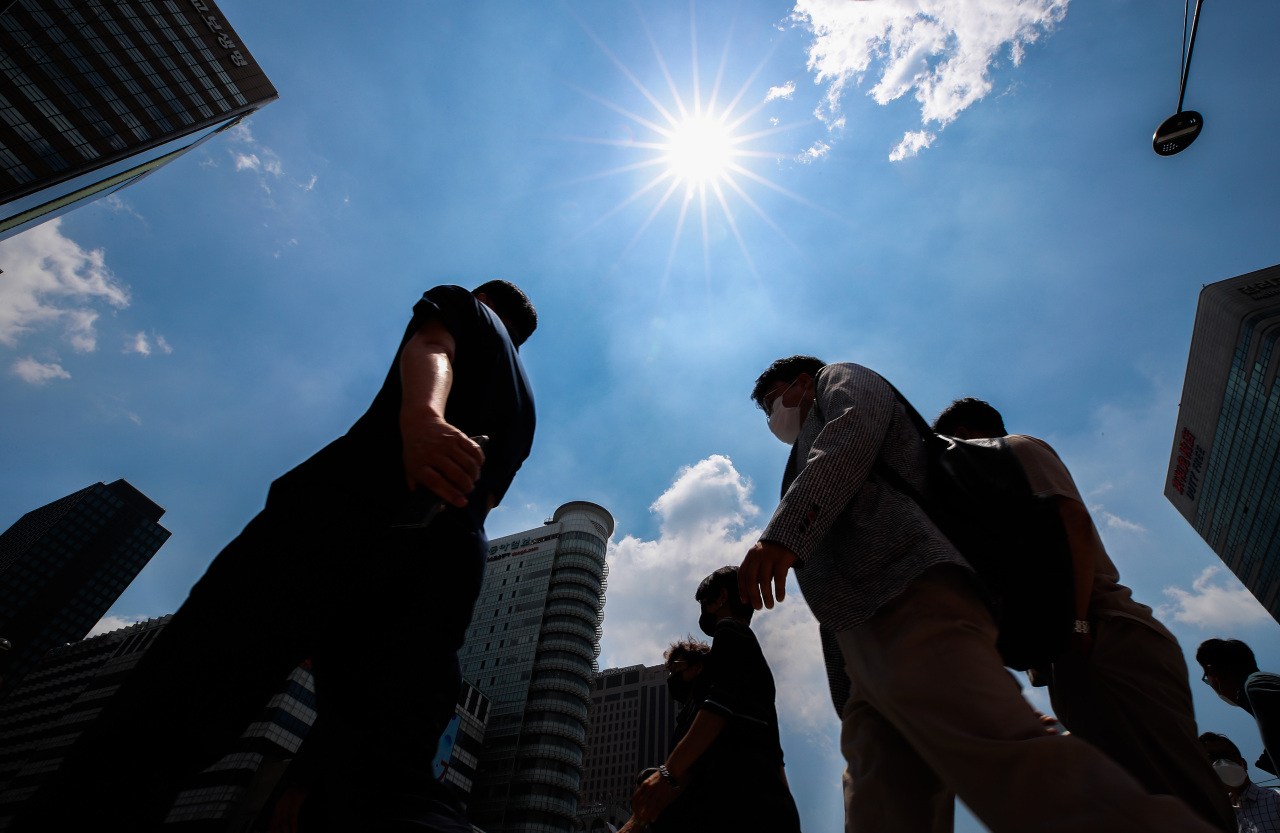 |
Pedestrians are seen walking past an alley in Gwanghwamun Square in central Seoul on Monday. (Yonhap) |
This is the second installment of a series of articles investigating financial activities of seniors during rapid digitalization of the finance industry. —Ed.
Three years ago, a 32-year-old software developer surnamed Park bought an individual retirement pension plan, not knowing exactly what his corporate pension plan was as an employee.
Holding a portfolio mix of stock funds and a bond fund, with one of the stock funds returning as high as 43 percent since inception, the private retirement plan is now offering him a financial return, a tax deduction and a sense of relief.
“I have doubts whether I‘ll be able to get the public pension payment regularly or not when I get older,” he said.
“Building my own pension portfolio makes me feel relieved about my future.“
Park is one of the many Koreans saving their cash in do-it-yourself private retirement plans for various benefits and perceive them as an act of investing. Observing the growth, financial institutions here are moving to capitalize on the burgeoning private pension marketplace supported by the government‘s tax break and the new rules over the past few years.
The changing environment allows more Korean private pension savers to take risks as they build up their pension pots, in order to avoid income poverty as they retire.
Moreover, the ample liquidity triggered by the COVID-19 pandemic is turning pension savers‘ attention away from the principal-income guaranteed financial products like deposits, recognizing a need to hedge inflation in the long run.
This trend comes as more Koreans find themselves prone to income poverty after retirement, although the nation has provided a multi-tiered, earnings-related retirement income regime that comprises public pension plans including the National Pension Service, as well as tax-favored private pensions.
According to the latest data by the Organization for Economic Cooperation and Development, 43.8 percent of those aged over 65 saw their income lower than 50 percent of the median equivalized household disposable income, and the ratio in Korea was the highest among all 41 countries surveyed in 2016.
The survey also showed that the difference between poverty among younger old -- or those aged 66-75 -- and older old at the age of over 75 was the highest in Korea.
In light of the old-age poverty concerns, as well as demographic changes that contribute to draining resources in the public pension system, more Koreans are turning to the private pension system that operates on a voluntary basis, having second thoughts about their extreme risk-avoiding behavior.
“More employees in Korea are creating, curating and executing pension strategies individually,” Kim Jin-woong, director of longevity research institute at NH Investment & Securities, told The Korea Herald.
“More people are looking to take advantage of financial investment products to get the best out of their pension pot especially in the low-interest setting.”
Individualism, risk for financial security
The pension marketplace shows a sign of maturing, 16 years after the concept of private pension in Asia’s fourth-largest economy set foot with the introduction of the Employee Retirement Security Act in 2005.
As of end-2020, Korean pension service providers have piled up an over 100 trillion won ($88.6 billion) contribution through private pension products where savers have autonomy in making an investment decision, according to an estimate by the Ministry of Employment and Labor.
These are either “defined contribution,” a scheme where an employee has a right to choose investment vehicles among at least three choices proposed by his or her employer; or “individual retirement pension,” which allows an individual to build an 18 million-won extra pension pot each year with higher spontaneity.
The two types accounted for nearly 40 percent of the total accumulated private pension pots as of 2020, up two percentage points from 2019.
Another expert said the nation is achieving financial inclusion in some ways.
“Koreans are becoming increasingly financially savvy, so that they can capitalize on the benefits from the DIY pension products such as financial returns and tax relief,” said Kim Sung-il, head of retirement research firm at Consulting Group Good Company.
 |
Pedestrians walk through Myeong-dong shopping district in Seoul on Monday. (Yonhap) |
More autonomy translates into a better chance of pursuing higher investment return, as well as a tax deduction of up to 1.1 million won each year.
If employers, not the employee, were responsible for pension planning and investment risk through “defined benefit” schemes, they were less likely to beat inflation as they tended to go for principal-protected pension schemes.
Until 2020, “defined benefit” products had 95.5 percent of total contribution placed in contracts that guarantee repayment of principal and a fixed- or floating-interest, showed data by the Labor Ministry. Such a tendency went lower for DIY pensions, by 10-20 percentage points.
As a result, DIY pensions annually yielded 0.2-0.4 percentage points more than the ones that employers were supervising, during the 2016-2020 period.
There are growing views that the extreme risk-averse approach had failed to deliver a proper rate of return to pension savers, in the country where beneficiaries of the National Pension Service receives less than 500,000 won each month on average.
To beef up returns of nationwide private pensions, Kim of CGGC called for a swift passage of a pending bill by lawmakers to allow employers to adopt automatic enrollment policy through a “default option” to increase employees’ participation in private pension plans.
Of the bill proposals on the National Assembly, one by the ruling Democratic Party lawmakers Rep. An Ho-young and Rep. Kim Byung-wook aims to force Korean firms to allocate employee contributions to collective investment schemes like funds under a default option, excluding principal-interest guaranteed instruments.
“The success behind corporate pension reform in Australia and the United States is hardly attributable to employees’ choice on free will, but instead, to a legal groundwork that is meant to boost pension performance by encouraging a default option,” said Kim of CGGC, who formerly led a retirement research center of local consultancy KG Zeroin.
Empowering pension saversKorea‘s pension marketplace is expected to grow exponentially as more companies are urged to employ an occupational pension system and ditch the severance pay plan with a new legislation.
Moreover, automated enrollment for DIY pensions will push more savings to be managed under corporate pension schemes.
Therefore, the market environment change is a boon to pension service providers -- financial institutions such as commercial banks, insurance firms and brokerage houses -- whose operational duty ranges from overall administration of funds to cash controls and record keeping.
This, on the other hand, has often left employers or employees with few options to handle freeloading pension service providers.
Some professionals here argue this often leaves Korean employers suffering from a lack of governance in managing the occupational pension reserves.
“Employers are unlikely to have an alternative choice (in their savings to defined contribution scheme), even though their employees find their corporate pension service unsatisfactory,” Austin Kweon, Country Manager of Aon Hewitt Consulting Korea, told The Korea Herald.
Kweon added that Aon has recently worked on behalf of an undisclosed Seoul-based corporate pension sponsor -- or an employer -- to help navigate whether its pension service providers had performed duly.
In order to do so, Aon had adopted an operational due diligence technique as part of the review process to gauge the efficiency in the practice of pension service providers, according to the company. The results of the review led to the client‘s decision to replace an undisclosed pension service provider.
More employers are likely to wrestle with capital efficiency to deal with large cash reserves and reduce the opportunity cost as they take pressure from this current low-interest environment.
“Sometimes, corporations begin to doubt whether it is desirable to hinge on pension service providers’ leadership as they allocate the cash reserve to the financial services firms,” Kweon said.
By Son Ji-hyoung (
consnow@heraldcorp.com)









